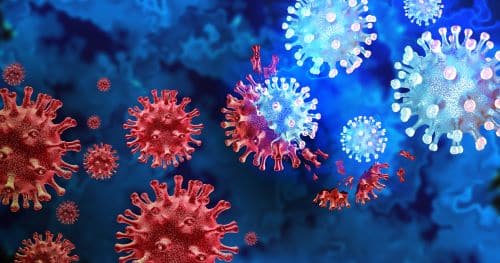
Disease Pandemics and the Population Factor
- Nathanial Gronewold
- August 30, 2024
- Forum Papers
- Forum Paper
- 0 Comments
Click here for a downloadable, printable PDF version.
An NPG Forum Paper
by Nathanial Gronewold
August 2024
ABSTRACT
It’s been only a few years since the world exited the height of the COVID-19 coronavirus pandemic, but we’re now facing a potentially deadlier new pandemic threat. This threat stems from a virus that health professionals have been monitoring for two decades: H5N1, more commonly known as bird flu or avian influenza. Once mostly the bane of chicken farmers, H5N1 has now infected domesticated animals and wild species worldwide. It’s now jumping from dairy cows to humans. Each day the threat grows worse. As with COVID-19, bird flu infections could quickly escalate into a pandemic, facilitated by our over-populated world.
This Forum paper you’re reading now may be a place for like-minded folks advocating for a smaller human population, but let’s all agree that no sane person alive would look forward to the pain that an avian flu pandemic could deliver. COVID-19 killed at least 7 million people worldwide in just three years; an H5N1 pandemic could be by orders of magnitude worse. We must do everything we can to prevent it while encouraging our society to embrace future population declines and a more sustainable economy for everyone.
THE NIGHTMARE
It’s very difficult for any alternate news item to get noticed during the noise of a US presidential election season, let alone the tumultuous 2024 cycle. This became nearly impossible after the June 27 presidential election debate. The debate and its aftermath were practically the only things in the news for days, even weeks. That’s why many of this Forum’s readers probably missed far more important news that ran the Tuesday following that debate. Here’s the July 2 headline by Forbes:
“Moderna scores federal funding for mRNA bird flu vaccine as pandemic fear grows.”1
The Associated Press (AP) put it this way:
“The US will pay Moderna $176 million to develop an mRNA pandemic bird flu vaccine.”2
This news, I assure you, is far more consequential than Joe Biden’s recent debate performance and his decision to drop out of the 2024 presidential race.
Quietly and without much fanfare, the US government awarded a contract to Moderna for the company to begin “late-stage development” of avian influenza vaccines capable of tackling newer emerging strains of H5N1. Moderna made the announcement to shareholders, which is how the media found out. AP said the $176 million investment is the federal government’s not-so-subtle way of telling Moderna to speed things up.
That’s because we’re running out of time.
Bird flu has been detected in every US state except Hawaii. As of this writing, it’s been detected on every continent except Australia – yes, bird flu has hit animal populations in Antarctica, and its rapid spread on the Antarctic peninsula is even disrupting penguin research there.3 A new H5N1 outbreak in animals may be discovered in Australia as well by the time this Forum paper is published. “Australia has had avian influenza outbreaks in poultry previously,” Dr. Debbie Eagles, Director of the Australian Center for Disease Preparedness, told me and others in a recent call she and her colleague, Frank Wong, held for reporters.
More than 160 dairy cattle herds in the United States are now infected with avian influenza.4 Normally, when this virus is detected on a farm the government orders all the animals to be killed. Maybe dairy farmers hold more political sway than chicken farmers because the authorities are simply monitoring the ongoing outbreak on dairy farms. They are assuring us that the risk to the public is low; yes, the H5N1 virus is in the cows’ milk, but the virus is destroyed during pasteurization, they say.
Indeed, as of this writing, the authorities on H5N1 are insisting that the threat to the human population is low. That’s what they said in the early days of COVID-19, but the situation this time around is different, I will admit. For starters, we know a threat is lurking and our scientists are keeping a close eye on things (we assume, or hope). By contrast, COVID- 19 caught the world completely off guard.
Since April, at least four US farm workers have contracted bird flu from dairy cows while nine have caught the virus at poultry farms, and these are just the ones we know about.5 Again, we’re told that the risk to the broader population is low since the virus hasn’t yet evolved to be passed from human to human. But it now passes from birds to a wide array of mammals, including domestic cats, penguins, sea lions, walruses, cows, and other species, including humans. Pessimists worry that it may be only a matter of time for a strain to evolve that spreads among humans as easily as the common cold. Thus, the Moderna contract and the frantic push to get a handle on this problem before it’s too late.
The ongoing US outbreak marks the first time ever that avian influenza has been discovered thriving in cattle and jumping from cows to humans. Thus far, the people who contracted the virus at dairy farms in Colorado are reported to have suffered only mild symptoms, suggesting that this particular strain hasn’t evolved to become too lethal to humans – we hope.
This hasn’t been the case in the past when people caught the virus directly from infected birds or bird carcasses. Of known cases of past bird-to-human infections, H5N1 killed about half its victims.
Why is bird flu a bigger story than the US presidential election? Because as terrible and traumatic as the COVID-19 pandemic was, COVID ultimately proved fatal in about 63 out of 100,000 cases, for a mortality rate of less than 0.1%. Bird flu has an estimated mortality rate of “somewhere between 25 and 50%” as former Centers for Disease Control director Robert Redfield said in a recent interview with News Nation.6 That means unless it can be stopped or quickly contained, a bird flu pandemic could conceivably kill billions in the time it took COVID to kill millions. “It’s not a question of if, it’s more of a question of when we will have a bird flu pandemic,” Redfield added.
Now weigh this level of lethality against all that we have learned about the near impossibility of stopping a viral pandemic in these modern times, thanks to our recent experience with the novel coronavirus…Continue reading the full Forum paper by clicking here.
Your gift helps publish and distribute materials like this.
Nathanial Gronewold is the author of Anthill Economics: Animal Ecosystems and the Human Economy
and A Tale of Two Cranes: Lessons Learned from Fifty Years of the Endangered Species Act. He holds a
Ph.D. in environmental science from Hokkaido University and teaches journalism and media operations as
a faculty member at the University of Hawaii at Manoa.


